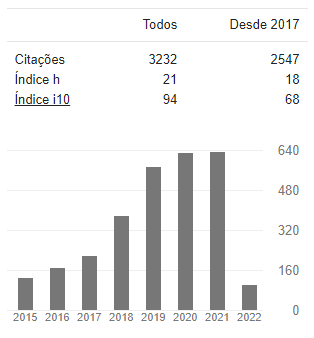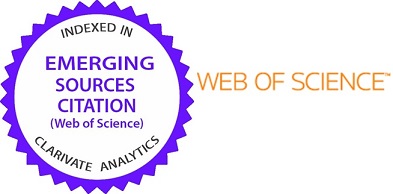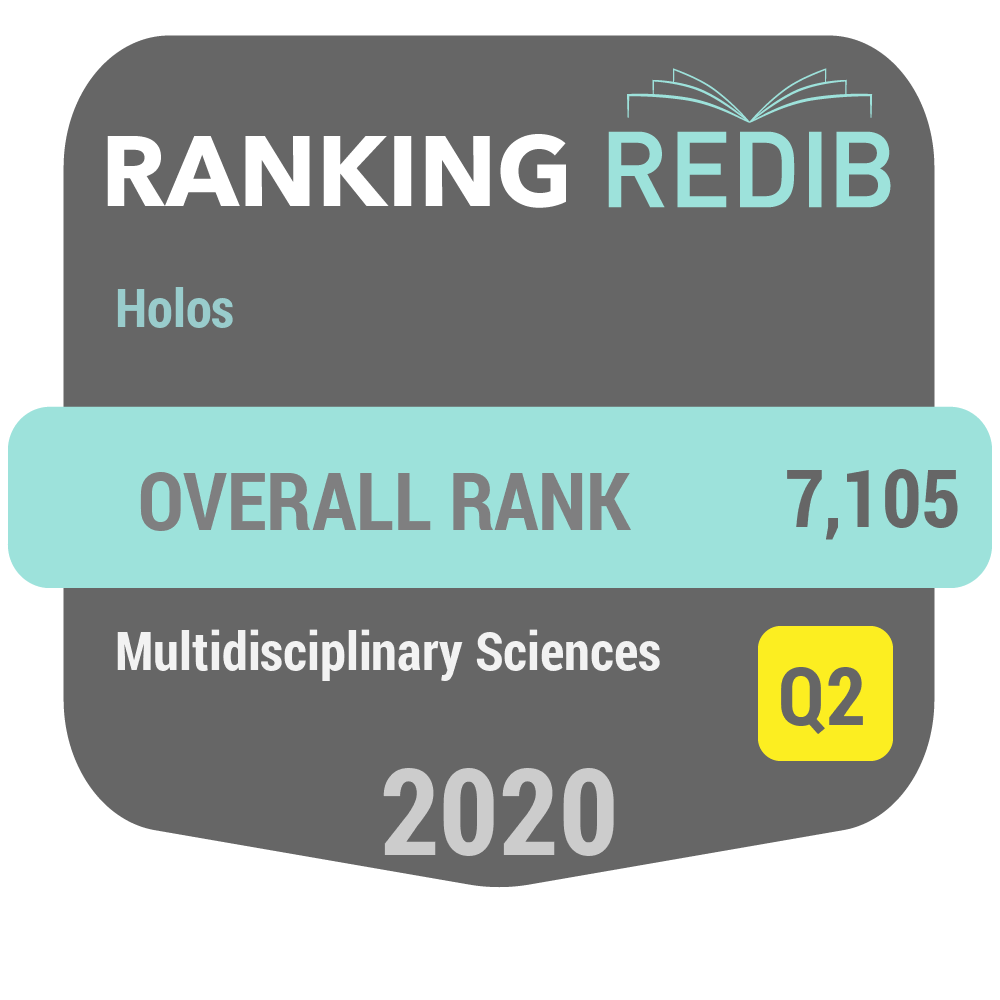EFEITO CITOTÓXICO DIFERENCIAL DO EXTRATO HIDROETANÓLICO DE ERVA-MATE (ILEX PARAGUARIENSIS) SOBRE ERITRÓCITOS E CÉLULAS MONONUCLEARES DE SANGUE PERIFÉRICO
DOI:
https://doi.org/10.15628/holos.2021.10257Palavras-chave:
Plantas medicinais, citotoxicidade, células sanguíneas, estresse oxidativoResumo
Para a utilização da erva-mate (Ilex paraguariensis) como planta medicinal, é necessário determinar concentrações e formas de utilização seguras e eficazes. Modelos in vitro de triagem de citotoxicidade fornecem dados preliminares para selecionar doses seguras potencialmente benéficas. O objetivo deste estudo foi avaliar a citotoxicidade aguda de diferentes concentrações de um extrato hidroetanólico de folhas de erva-mate em dois modelos de células sanguíneas humanas. Para isso, eritrócitos e células mononucleares de sangue periférico de 10 indivíduos saudáveis foram incubadas com diferentes concentrações do extrato hidroetanólico de erva-mate por 150 minutos a 37°C. Após a incubação, foram realizados testes bioquímicos de detecção de citotoxicidade. A concentração de 1000µg/mL de extrato aumentou a hemólise, a fragilidade osmótica e a peroxidação lipídica em eritrócitos, mas não teve efeito citotóxico em células mononucleares. Estes dados sugerem que altas concentrações de extrato podem ser tóxicas para alguns tipos celulares e, por isso, concentrações seguras de utilização são essenciais para a recomendação da erva-mate como planta medicinal.
Downloads
Referências
Alves, A. O., Weis, G. C. C., Unfer, T. C., Assmann, C. E., Barbisan, F., Azzolin, V. F., . . . da Cruz, I. B. M. (2019). Caffeinated beverages contribute to a more efficient inflammatory response: Evidence from human and earthworm immune cells. Food Chem Toxicol, 134, 110809. doi: 10.1016/j.fct.2019.110809 DOI: https://doi.org/10.1016/j.fct.2019.110809
Bains, Y., & Gugliucci, A. (2017). Ilex paraguariensis and its main component chlorogenic acid inhibit fructose formation of advanced glycation endproducts with amino acids at conditions compatible with those in the digestive system. Fitoterapia, 117, 6-10. doi: 10.1016/j.fitote.2016.12.006 DOI: https://doi.org/10.1016/j.fitote.2016.12.006
Baran, A., Gruszecka-Kosowska, A., Kolton, A., Jasiewicz, C., & Piwowar, P. (2018). Content and health risk assessment of selected elements in the Yerba mate (Ilex paraguariensis, St. hillaire). Human and Ecological Risk Assessment: An International Journal, 24(4), 1092-1114. DOI: https://doi.org/10.1080/10807039.2017.1406304
Becker, A. M., Cunha, H. P., Lindenberg, A. C., de Andrade, F., de Carvalho, T., Boaventura, B. C. B., & da Silva, E. L. (2019). Spray-Dried Yerba Mate Extract Capsules: Clinical Evaluation and Antioxidant Potential in Healthy Individuals. Plant Foods Hum Nutr, 74(4), 495-500. doi: 10.1007/s11130-019-00764-4 DOI: https://doi.org/10.1007/s11130-019-00764-4
Bonfanti-Azzolin, G., Zambra, A. L., Silva, B. M. d., Bona, K. S. D., Bitencourt, P. E. R., Cargnelutti, L., . . . Gonçalves, T. d. L. (2019). Toxicity assessment of Syzygium jambos and Solanum guaraniticum hydroethanolic leaf extracts thru Artemia salina lethality and spleen lymphocyte cytotoxicity tests. International Educative Research Foundation and Publisher, 7(10), 133. DOI: https://doi.org/10.31686/ijier.vol7.iss10.1758
Bonfanti, G., Bona, K. S., Lucca, L., Jantsch, L., Pigatto, A. S., Boligon, A. A., . . . Goncalves Tde, L. (2014). Delta-ALA-D inhibitory potential and protective action of Syzygium jambos and Solanum guaraniticum leaf extracts on oxidatively stressed erythrocytes. Redox Rep, 19(5), 206-213. doi: 10.1179/1351000214Y.0000000092 DOI: https://doi.org/10.1179/1351000214Y.0000000092
Borenfreund, E., & Puerner, J. A. (1984). A simple quantitative procedure using monolayer cultures for cytotoxicity assays (HTD/NR-90). Journal of tissue culture methods, 9, 7-9. DOI: https://doi.org/10.1007/BF01666038
Boyne, A. F., & Ellman, G. L. (1972). A methodology for analysis of tissue sulfhydryl components. Anal Biochem, 46(2), 639-653. doi: 10.1016/0003-2697(72)90335-1 DOI: https://doi.org/10.1016/0003-2697(72)90335-1
Bracesco, N., Sanchez, A. G., Contreras, V., Menini, T., & Gugliucci, A. (2011). Recent advances on Ilex paraguariensis research: minireview. J Ethnopharmacol, 136(3), 378-384. doi: 10.1016/j.jep.2010.06.032 DOI: https://doi.org/10.1016/j.jep.2010.06.032
Caulier, A., Guyonneau Harmand, L., & Garcon, L. (2017). [Immortalization of erythroid progenitors for in vitro large-scale red cell production]. Transfus Clin Biol, 24(3), 263-267. doi: 10.1016/j.tracli.2017.06.030 DOI: https://doi.org/10.1016/j.tracli.2017.06.030
Correa, V. G., de Sa-Nakanishi, A. B., Goncalves, G. A., Barros, L., Ferreira, I., Bracht, A., & Peralta, R. M. (2019). Yerba mate aqueous extract improves the oxidative and inflammatory states of rats with adjuvant-induced arthritis. Food Funct, 10(9), 5682-5696. doi: 10.1039/c9fo00491b DOI: https://doi.org/10.1039/C9FO00491B
Ekor, M. (2014). The growing use of herbal medicines: issues relating to adverse reactions and challenges in monitoring safety. Frontiers in pharmacology, 4, 177. DOI: https://doi.org/10.3389/fphar.2013.00177
Fonseca, C. A., Otto, S. S., Paumgartten, F. J., & Leitao, A. C. (2000). Nontoxic, mutagenic, and clastogenic activities of Mate-Chimarrao (Ilex paraguariensis). J Environ Pathol Toxicol Oncol, 19(4), 333-346.
Gan, R. Y., Zhang, D., Wang, M., & Corke, H. (2018). Health Benefits of Bioactive Compounds from the Genus Ilex, a Source of Traditional Caffeinated Beverages. Nutrients, 10(11). doi: 10.3390/nu10111682 DOI: https://doi.org/10.3390/nu10111682
Heck, C. I., & de Mejia, E. G. (2007). Yerba Mate Tea (Ilex paraguariensis): a comprehensive review on chemistry, health implications, and technological considerations. J Food Sci, 72(9), R138-151. doi: 10.1111/j.1750-3841.2007.00535.x DOI: https://doi.org/10.1111/j.1750-3841.2007.00535.x
Hermann, P. B., Pianovski, M. A. D., Henneberg, R., Nascimento, A. J., & Leonart, M. S. S. (2016). Marcadores de estresse oxidativo em eritrócitos de crianças com doença falciforme. Jornal de Pediatria, 92(4), 394-399. DOI: https://doi.org/10.1016/j.jpedp.2016.04.005
Lingabathula, H., & Yellu, N. (2016). Cytotoxicity, oxidative stress, and inflammation in human Hep G2 liver epithelial cells following exposure to gold nanorods. Toxicol Mech Methods, 26(5), 340-347. doi: 10.3109/15376516.2016.1164268 DOI: https://doi.org/10.3109/15376516.2016.1164268
Lubin, J. H., De Stefani, E., Abnet, C. C., Acosta, G., Boffetta, P., Victora, C., . . . Dawsey, S. M. (2014). Mate drinking and esophageal squamous cell carcinoma in South America: pooled results from two large multicenter case-control studies. Cancer Epidemiol Biomarkers Prev, 23(1), 107-116. doi: 10.1158/1055-9965.EPI-13-0796 DOI: https://doi.org/10.1158/1055-9965.EPI-13-0796
Maheshwari, N., Khan, F. H., & Mahmood, R. (2019). Pentachlorophenol-induced cytotoxicity in human erythrocytes: enhanced generation of ROS and RNS, lowered antioxidant power, inhibition of glucose metabolism, and morphological changes. Environ Sci Pollut Res Int, 26(13), 12985-13001. doi: 10.1007/s11356-019-04736-8 DOI: https://doi.org/10.1007/s11356-019-04736-8
Mosmann, T. (1983). Rapid colorimetric assay for cellular growth and survival: application to proliferation and cytotoxicity assays. J Immunol Methods, 65(1-2), 55-63. doi: 10.1016/0022-1759(83)90303-4 DOI: https://doi.org/10.1016/0022-1759(83)90303-4
Munoz-Culla, M., Saenz-Cuesta, M., Guereca-Barandiaran, M. J., Ribeiro, M. L., & Otaegui, D. (2016). Yerba mate (Ilex paraguariensis) inhibits lymphocyte activation in vitro. Food Funct, 7(11), 4556-4563. doi: 10.1039/c6fo01061j DOI: https://doi.org/10.1039/C6FO01061J
Noureddine, T., El Husseini, Z., Nehme, A., & Abdel Massih, R. (2018). Antibacterial activity of Ilex paraguariensis (Yerba Mate) against Gram-positive and Gram-negative bacteria. J Infect Dev Ctries, 12(9), 712-719. doi: 10.3855/jidc.10380 DOI: https://doi.org/10.3855/jidc.10380
Peralta, I. N., Cogoi, L., Filip, R., & Anesini, C. (2013). Prevention of hydrogen peroxide-induced red blood cells lysis by Ilex paraguariensis aqueous extract: participation of phenolic and xanthine compounds. Phytother Res, 27(2), 192-198. doi: 10.1002/ptr.4700 DOI: https://doi.org/10.1002/ptr.4700
Pereira, A. A. F., Tirapeli, K. G., Chaves-Neto, A. H., da Silva Brasilino, M., da Rocha, C. Q., Bello-Klein, A., . . . Nakamune, A. (2017). Ilex paraguariensis supplementation may be an effective nutritional approach to modulate oxidative stress during perimenopause. Exp Gerontol, 90, 14-18. doi: 10.1016/j.exger.2017.01.011 DOI: https://doi.org/10.1016/j.exger.2017.01.011
Peterson, G. L. (1977). A simplification of the protein assay method of Lowry et al. which is more generally applicable. Anal Biochem, 83(2), 346-356. doi: 10.1016/0003-2697(77)90043-4 DOI: https://doi.org/10.1016/0003-2697(77)90043-4
Petrilli, A. A., Souza, S. J., Teixeira, A. M., Pontilho, P. M., Souza, J. M., Luzia, L. A., & Rondo, P. H. (2016). Effect of Chocolate and Yerba Mate Phenolic Compounds on Inflammatory and Oxidative Biomarkers in HIV/AIDS Individuals. Nutrients, 8(5). doi: 10.3390/nu8050132 DOI: https://doi.org/10.3390/nu8050132
Pilatti-Riccio, D., Santos, D. F. d., DillenburgMeinhart, A., AntonioKnapp, M., Hackbart, H. C. d. S., & ZanellaPinto, V. (2019). Impact of the use of saccharides in the encapsulation of Ilex paraguariensis extract. Food Research International, 125, 108-600. DOI: https://doi.org/10.1016/j.foodres.2019.108600
Piovezan-Borges, A. C., Valerio-Junior, C., Goncalves, I. L., Mielniczki-Pereira, A. A., & Valduga, A. T. (2016). Antioxidant potential of yerba mate (Ilex paraguariensis St. Hil.) extracts in Saccharomyces cerevisae deficient in oxidant defense genes. Braz J Biol, 76(2), 539-544. doi: 10.1590/1519-6984.01115 DOI: https://doi.org/10.1590/1519-6984.01115
Pires, C. W., Botton, G., Cadona, F. C., Machado, A. K., Azzolin, V. F., da Cruz, I. B., . . . Praetzel, J. R. (2016). Induction of cytotoxicity, oxidative stress and genotoxicity by root filling pastes used in primary teeth. Int Endod J, 49(8), 737-745. doi: 10.1111/iej.12502 DOI: https://doi.org/10.1111/iej.12502
Portela, J. L., Soares, D., Rosa, H., Roos, D. H., Pinton, S., Avila, D. S., & Puntel, R. L. (2017). Ilex paraguariensis crude extract acts on protection and reversion from damage induced by t-butyl hydroperoxide in human erythrocytes: a comparative study with isolated caffeic and/or chlorogenic acids. J Sci Food Agric, 97(7), 2007-2014. doi: 10.1002/jsfa.8001 DOI: https://doi.org/10.1002/jsfa.8001
Pourahmad, J., & Salimi, A. (2015). Isolated Human Peripheral Blood Mononuclear Cell (PBMC), a Cost Effective Tool for Predicting Immunosuppressive Effects of Drugs and Xenobiotics. Iran J Pharm Res, 14(4), 979.
PRÁ, D., GUECHEVA, T., FRANKE, S. I. R., KNAKIEVICZ, T., ERDTMANN, B., & HENRIQUES, J. A. P. (2006). Toxicidade e Genotoxicidade do Sulfato de Cobre em Planárias de Água Doce e Camundongos. Revista da Sociedade Brasileira de Ecotoxicologia, 2(2), 171-175. DOI: https://doi.org/10.5132/jbse.2006.02.016
Prabst, K., Engelhardt, H., Ringgeler, S., & Hubner, H. (2017). Basic Colorimetric Proliferation Assays: MTT, WST, and Resazurin. Methods Mol Biol, 1601, 1-17. doi: 10.1007/978-1-4939-6960-9_1 DOI: https://doi.org/10.1007/978-1-4939-6960-9_1
Prediger, R. D., Fernandes, M. S., Rial, D., Wopereis, S., Pereira, V. S., Bosse, T. S., . . . Costa-Campos, L. (2008). Effects of acute administration of the hydroalcoholic extract of mate tea leaves (Ilex paraguariensis) in animal models of learning and memory. J Ethnopharmacol, 120(3), 465-473. doi: 10.1016/j.jep.2008.09.018 DOI: https://doi.org/10.1016/j.jep.2008.09.018
Rivelli, D. P., Almeida, R. L., Ropke, C. D., & Barros, S. B. (2011). Hydrolysis influence on phytochemical composition, antioxidant activity, plasma concentration, and tissue distribution of hydroethanolic Ilex paraguariensis extract components. J Agric Food Chem, 59(16), 8901-8907. doi: 10.1021/jf201665t DOI: https://doi.org/10.1021/jf201665t
Simões, C. M. O., Schenkel, E. P., Mello, J. C. P. d., Mentz, L. A., & Petrovick, P. R. (2016). Farmacognosia: Do Produto Natural ao Medicamento (G. A Ed. 1 ed.).
Stockert, J. C., Horobin, R. W., Colombo, L. L., & Blazquez-Castro, A. (2018). Tetrazolium salts and formazan products in Cell Biology: Viability assessment, fluorescence imaging, and labeling perspectives. Acta Histochem, 120(3), 159-167. doi: 10.1016/j.acthis.2018.02.005 DOI: https://doi.org/10.1016/j.acthis.2018.02.005
Wnuk, M., Lewinska, A., Oklejewicz, B., Bugno, M., Slota, E., & Bartosz, G. (2009). Evaluation of the cyto- and genotoxic activity of yerba mate (Ilex paraguariensis) in human lymphocytes in vitro. Mutat Res, 679(1-2), 18-23. doi: 10.1016/j.mrgentox.2009.07.017 DOI: https://doi.org/10.1016/j.mrgentox.2009.07.017









































